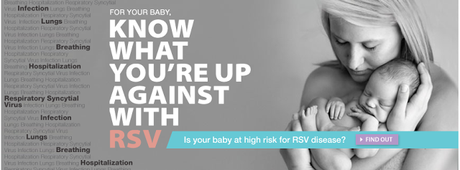About 82% of U.S. children from six week to six years old spend some time in childcare and that means they are at a higher risk of being sick - runny nose, stomach viruses, fever, cough you name it, they got it! Little L isn't in daycare, but Little M is and I have to be even more careful to not pass on nasties to her and ensure she stays healthy. Not always an easy task.
Unfortunately because kids immune systems are not yet fully developed and they lack good personal hygiene their chances of catching and spreading viruses such as Respiratory Syncytial Virus (RSV) increases. RSV is a common, seasonal virus that affects two-thirds of all infants by age one and almost 100% of babies by age two. One hundred percent?! I had NO clue and it got me thinking that Little L has been in contact with Little M's classmates when I pick him up and she is only a month old. Yikes!

RSV can live on surfaces (doorknobs, counter tops, toys, bedding) for several hours and is often spread through touching, hugging and kissing. When I pick up Little M from preschool each day he is sweaty and dirty with sticky hands after playing, sharing toys and tables and eating and napping in close proximity. All good and natural for a four year old, but clearly at high risk to get something and passing it on to his baby sister.
Symptoms are cold-like but in babies can result in a serious respiratory infection (especially in premature infants). Good news is that the RSV season is nearly over - it typically runs from November to March. However, these severe RSV symptoms require immediate medical attention:
- Coughing or wheezing that does not stop
- Fast or troubled breathing
- Spread out nostrils and/or a caved in chest when trying to breathe
- Bluish color around the mouth for fingernails
- Fever - especially over 100.4 F in infants under 3 months
Just remember (and I know how difficult it is) but I think as parents we can all help each other out by keeping a sick child at home to avoid spreading it to other children. There really is no treatment for RSV, so we really have to stick together on this one and make sure we wash their hands throughout the day, wash toys and sheets and avoid crowds during the peak months.
I had no idea about RSV and the effects it had on a newborn, especially after knowing that she has already been exposed to it. Of course if you have any doubts or think your child may have it, see your pediatrician or family doctor immediately.
Let's avoid the nasties and keep the little ones healthy!
More information #RSVProtection | www.RSVProtection.com
*This is a sponsored post with Latina Bloggers Connect. All opinions and personal experiences with the nasties are my own*

